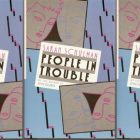Finding the Formula in a 20th Century Fiction Factory
I was only a few pages in when I understood I wouldn’t be finishing The Outdoor Girls In a Motorcar, a 1913 book from a series called, appropriately, The Outdoor Girls. I’ve already written about not finishing good books, and that wasn’t the issue this time. In fact, it was quite the opposite. The whole first chapter of In a Motorcar felt, well… Too predictable.
But that, I’ve come to understand, was intentional.
“As oil has its Rockefeller, literature has its Stratemeyer,” wrote Fortune magazine in 1934. Edward Stratemeyer was a writer turned fiction factory foreman. The business he built—the Stratemeyer Syndicate—is responsible for much-loved book series like Nancy Drew, The Hardy Boys and The Bobbsey Twins.
In Stratemeyers’s early business model, he came up with story ideas, outlined the plots and then payed others to do the actual sentence work. Writers wrote under a pseudonym and the stories themselves were sold to various publishers (the Syndicate retained original ownership). What resulted was an assembly-line of ghost writers, thirty titles a year feeding roughly thirty-one unique series for juveniles. For more than 70 years.
Stratemeyers’s “recipe” for producing a book in roughly 40 days went as follows:
- 25 chapters per book, each ending with a cliff-hanging episode
- No touching or kissing, and no upsetting violence
- No character could be knocked unconscious more than once per book
- Action had to be intense enough to require exclamation marks
Another way to describe this process would be formulaic, or, as I quickly noticed in my reading of The Outdoor Girls, canned; as early as 1905, the Syndicate was attacked for its lack of literariness, and adults were less than thrilled with the formulaic approach to children’s literature. “Sensationalist,” “tawdry,” “trashy,” “vulgar,” and “cheap” were words often used to describe the books in a Stratemeyer series. But kids sure loved it, and they consumed the books like crazy. That’s not to say all of the Syndicate’s series succeeded, but the ones that did did very well. So well that they are still in print today.
So what’s the deal with a formulaic approach. Is it always bad?
For many, many years I loved Law & Order. I loved being in the courtroom with Jack, and the whiskeyed conversations with his boss and whoever his assistant DA was at the time, and the ever-predictable wrap-ups. I loved Lenny (RIP) and his predictable one-liners. Even today, settling into a rerun is deeply satisfying. The formula works for me—it’s relaxing, entertaining, and has just enough intrigue to keep me interested. Formulas carry a familiarity with them that readers (and viewers) both crave and appreciate.
Judging by Stratemeyer’s million-dollar estate at the time of his death, he quite successfully connected with this human need for familiarity, particularly with juveniles. In the bewildering early adolescent years, having familiar characters and mysteries to get lost in can be quite a lifeline. Stratemeyer’s been called the “Father of the Fifty Center” for how he made juvenile stories so easily available to the masses. And it’s no small thing that his business survived the Great Depression.
 But if I hadn’t loved Nancy Drew as a youngster, I’d probably be aligning myself more closely with the adult critiques of 1905. I’ve confessed to a new appreciation for serial work, so what I find myself mulling over as I consider the Stratemeyer Syndicate and its legacy, is, once again, that maybe what’s popular and what’s literary aren’t as far apart as they initially seem. Both are reaching toward that shared human experience.
But if I hadn’t loved Nancy Drew as a youngster, I’d probably be aligning myself more closely with the adult critiques of 1905. I’ve confessed to a new appreciation for serial work, so what I find myself mulling over as I consider the Stratemeyer Syndicate and its legacy, is, once again, that maybe what’s popular and what’s literary aren’t as far apart as they initially seem. Both are reaching toward that shared human experience.
Stratemeyer, it’s obvious, genuinely loved a good story, and he found a way to sell it. Over the span of his lifetime he wrote roughly 200 books and outlined or edited around 800. I’ve yet to finish writing one.
And although I’ve moved quite a bit over my lifetime and “cleaned out” bookshelves dozens of times, you know which books have made the cut time after time? My handful of Nancy Drews.



